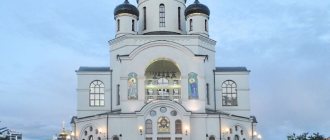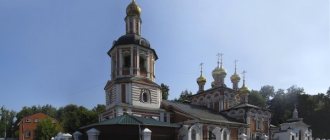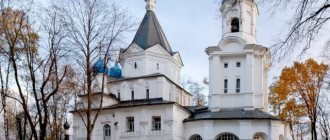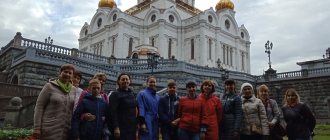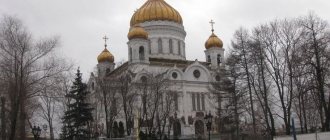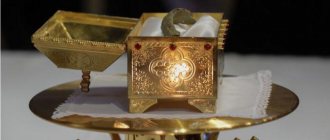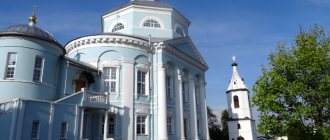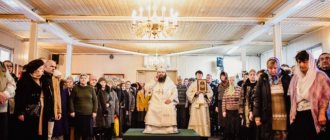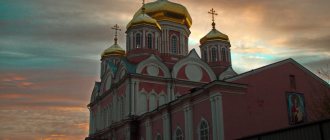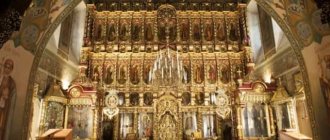The Cathedral of Christ the Savior is a cathedral of the Russian Orthodox Church. Built in 1997 on the banks of the Moskva River in Moscow, next to the Kremlin. It is one of the tallest Orthodox religious buildings in the world (103 meters). The current structure of the cathedral is not an original building, it is a reconstruction. The original cathedral, which took over forty years to build, was built in the 19th century.
The cathedral fell under the Moscow reconstruction program and was demolished in 1931 to build the Palace of the Soviets in its place, where the country's government was to be located. Construction began in 1937, but was stopped in 1941 due to lack of funding, errors and inaccuracies in construction plans, and the outbreak of World War II. The palace was never built. After the collapse of the Soviet Union, the cathedral was restored in its original location using donations collected.
History of the Cathedral of Christ the Savior
When Napoleon Bonaparte retreated from Moscow, Tsar Alexander I signed a manifesto on December 25, 1812, declaring his intention to build a cathedral in honor of Christ the Savior, and as a monument to the bravery of Russian soldiers.
The first completed architectural project of Alexander Lavrentievich Vitberg was approved by the Tsar in 1817. Construction work began on Vorobyovy Gory, the highest point in Moscow, but the site turned out to be unsuitable for the construction of such a large-scale building. In 1837, a new site was chosen closer to the Moscow Kremlin.
The cathedral took many decades to build; the scaffolding was not removed until 1860. The best Russian artists (Ivan Kramskoy, Vasily Surikov, V.P. Vereshchagin) continued to decorate the interior for another twenty years.
The cathedral's giant dome was gilded using a new gold galvanization technique, replacing the older and unsafe mercury gilding technique. The inner sanctuary of the church was surrounded by a two-story gallery, the walls of which were inlaid with rare varieties of marble, granite and other stones.
More than 1,000 marble tablets were displayed on the walls, listing the main commanders, regiments and battles of the Patriotic War of 1812, with lists of awards and casualties attached.
After the revolution of 1917, within the framework of new atheistic views, it was decided to demolish the temple. The site of the cathedral was chosen as the proposed site for the construction of the Palace of the Soviets.
The cathedral was blown up on December 5, 1931. It took more than a year to dismantle the remains of the temple. However, later the idea of building the Palace of the Soviets was abandoned. On the site of the bombed temple in 1958, the world's largest open-air swimming pool appeared.
In February 1990, the Russian Orthodox Church received permission to restore the temple.
About a million Muscovites donated money for this project. In the fall of 1994, the Moscow pool was destroyed and reconstruction of the cathedral began. The cathedral was consecrated on the Day of the Transfiguration of the Lord, August 19, 2000.
Video: history of the Cathedral of Christ the Savior
Bright Resurrection of Christ 2021: what time does the Easter service begin and end?
The Bright Resurrection of Christ is the most anticipated, bright and joyful day for which believers prepare in advance. Easter is preceded by the strict period of Lent. It is a kind of preparation for this most important holiday, through intense spiritual work, cleansing the soul and body. The strictest days of fasting are Good Friday and Holy Saturday. Well, and finally, believers must defend the Easter service - this is the only way, according to church ministers, that they can truly celebrate this great holiday.
The peculiarity of the Easter service is that it lasts the whole night. It starts on Saturday evening and ends only on Sunday morning. And since Easter falls on May 2 this year, the Easter service will begin on May 1.
It is worth noting that in the last days of Holy Week, the doors of churches always remain open so that each person can stay in church as long as he needs. And therefore, on Saturday, believers can come to the temple at any time. But usually during the day, housewives prepare festive dishes and collect food for the consecration ceremony, so everyone comes to church only in the evening. The service itself in almost all churches begins exactly at midnight from Saturday to Sunday.
Architectural features of the Temple
The restored temple is largely similar in appearance to the original structure.
Like the original building, the reconstructed cathedral was built in a style widely used in particular in Moscow at the end of the 19th century, based on the traditions of Old Russian architecture combined with elements of Byzantine architecture. Old Russian architectural components can be seen on its facade: arched windows typical of Russian Orthodox churches of the 15th and 16th centuries (60 in total) and gates (three on each side), as well as decorative ornaments and four pointed bell towers with onion-domed roofs.
The construction of the dome, however, comes from the Byzantine church tradition. The roof is topped by five domes, four of which are symmetrically arranged around a large central dome with a diameter of 30 meters.
During the construction of the cathedral in the 19th century, its facade was decorated with sculptures that depicted motifs from the Old Testament and Russian history. The authors of these sculptures were famous sculptors of that time, including Pyotr Klodt and Fyodor Tolstoy. During the reconstruction, the ornaments were recreated in a similar form by modern sculptors. Some of the surviving original sculptures are in the Donskoy Monastery in Moscow.
The interior of the cathedral reaches a ceiling height of 79 m in the area of the main dome and can accommodate up to 10,000 people. This makes the cathedral the largest Russian Orthodox church in the world. The central element of its space is the altar with an almost 27-meter-high iconostasis in the form of a chapel.
The architectural complex of the Cathedral of Christ the Savior also includes the Church of the Transfiguration of the Lord, which was built in August 1996. It is one of the few components of the temple that did not exist in the original building.
Next to the Transfiguration Church, in the basement, there is a museum that tells about the history of the cathedral, its construction, destruction and reconstruction. Parts of the original frescoes that decorated the interior walls before they were demolished in 1931 can also be seen in the museum. In addition, in the basement there is a conference hall of the Russian Orthodox Synod, a hall for holding events, several festive dining rooms, as well as office space.
Video: panoramic overview of the Cathedral of Christ the Savior (inside and outside)
Architecture
The front side of the temple is divided by four pillars into three parts, of which the middle one is larger than the outer ones and leads to the three exit doors of the temple: southern, northern and western. There are 36 wall pillars (columns) in total. They support the cornice of the temple, on which 20 semicircular pointed arches (kokoshniks) are placed: three arches on the front sides of the ledges and two on the corners of the building. The entire building is crowned with five helmet-shaped domes, of which the middle one is much larger than the others. This gives the entire building unity and beauty. The round wall of the middle chapter rests on an 8-sided base. Other chapters are located on the corners emerging between the projections and have the shape of octagonal towers. The style of the domes corresponds to the general character of the building: they taper at the top, like the heads of all Russian churches. Four colossal pillars inside the temple support the building. From the location of these pillars and projections, two walls are formed - internal and external, and between them a corridor, running, according to the custom of ancient Christian churches, around the entire temple. The upper part of this corridor consists of choirs decorated with paintings with two side churches built in them: in them the Wonderworker Nicholas and the Holy Prince Alexander Nevsky. The main altar is dedicated to the Nativity of Christ; its iconostasis is made in the form of a white marble chapel with a gilded bronze top. The entire building is illuminated by 60 windows: 16 of them are located in the main dome, 36 above the choir and 8 in the corridor.
Let us now say a few words about the domes and roof of the Temple. The colossal vault of the large dome represents with its structure one of the most remarkable phenomena in the field of architecture. The domes are made of stainless steel coated with titanium nitride, onto which a thin layer of gold is ion-sputtered. For better protection from atmospheric influences, the domes are coated with a thin layer of diamond dust (technical diamonds).
Below, on each of the four sides, there is a porch with a parapet made of fine-grained dark red granite. These porches, consisting of 15 steps the full length of the projections, with large landings, lead us to the front doors. There are 12 outer doors in the Temple, three on each face of the four projections. They are cast from bronze, with the middle one being larger than the outer ones. In the arches and niches of large and in the arches of small doors there are images of Saints with inscriptions. The general meaning and meaning of these figures is often the same as that of wall paintings.
Facts about the Cathedral of Christ the Savior
The Cathedral of Christ the Savior was restored through public fundraising - more than a million people donated money for construction.
According to the original design, the construction site of the temple was Vorobyovy Gory (the highest point in Moscow).
The Cathedral of Christ the Savior is the highest (103.5 m) and most spacious (up to ten thousand visitors) temple of the Russian Orthodox Church.
There are five bells in the bell ensemble of the cathedral - the smallest of them weighs five tons, the largest, which rings only on special occasions, weighs almost 30 tons.
The temple is not only a church building, but also a cenotaph in honor of Russian soldiers who died in the Patriotic War of 1812.
Easter celebration
The large-scale celebration of Orthodox Easter in 2021 will take place on May 2. On the eve of Easter, between morning and night services, Easter treats are blessed in churches - colored eggs, Easter cakes, Easter cottage cheese. The morning service on Holy Saturday, which falls on May 1, is special and quite long, and therefore often begins earlier than the usual time for the Liturgy, and ends later.
On Saturday evening, the Acts of the Holy Apostles are read in the church, followed by Easter Matins at 00 o'clock from the Procession of the Cross. It consists of the singing of the Easter canon, exclamations about the Resurrection of Christ, as well as the reading of the Catechetical Word of St. John Chrysostom. After this, a unique night Easter Liturgy is celebrated with the reading of the Gospel in different languages.
How to get there
The most convenient way to get there is by metro. The closest metro station to the cathedral is Kropotkinskaya. When leaving the metro, you need to choose the exit “To the Cathedral of Christ the Savior” (the last car from the center).
The cathedral is located in the historical center of Moscow (Volkhonka street, 15). If you came to Moscow specifically, you can choose nearby metro stations to take a walk.
For example, you can get off at the Arbatskaya metro station (blue line) and walk to the street. Volkhonka along the Boulevard Ring. Or you can get to the Borovitskaya station or the Lenin Library and walk to the Cathedral of Christ the Savior along Mokhovaya Street, and then along Volkhonka.
There are many interesting places to visit nearby: State Museum of Fine Arts named after A.S. Pushkin, Monument to Alexander II, Patriarchal Bridge, Muzeon Park, Red October factory buildings, Tretyakov Gallery on Krymsky Val, Alexander Garden, Kremlin.
Video: how to get to the temple
Shrines
- A piece of the Robe of our Lord and Savior Jesus Christ
- Holy relics of Metropolitan Philaret (Drozdov) of Moscow
- Ark with particles of holy relics
- Robe of the Blessed Virgin Mary
- Head of Saint John Chrysostom
- Relics of Blgv. led book Alexander Nevsky
- Relics of St. Met. Jonah Moscow
- Relics of Ravnoap. led book Vladimir
- Relics of St. Mary of Egypt and Blgv. book Mikhail Tverskoy
- Relics of St. Peter Metropolitan of Moscow
- Relics of St. Basil the Great
- Relics of John the Baptist
- Relics of Ap. Andrew the First-Called
- Nail of the Holy Cross
- Relics of St. Mikhail Malein
- Relics of the Holy Martyr. Theodore Stratelates
- The relics of Vlkm. Euphemia All-praise
- Head of St. Gregory the Theologian
- Relics of St. Euphrosyne of Moscow
Based on materials from azbyka.ru
